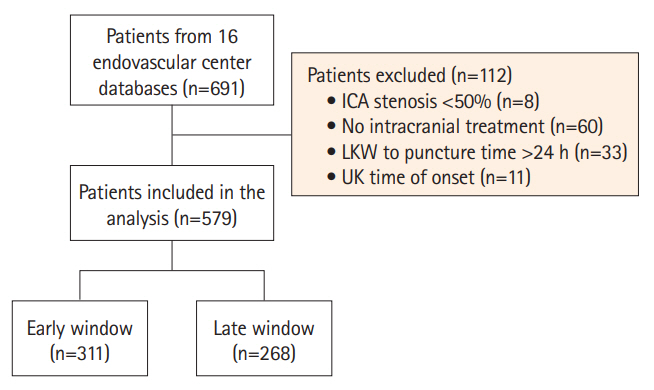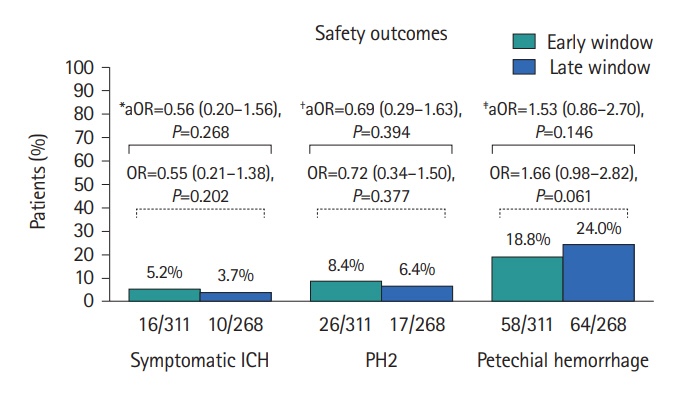J Stroke.
2023 Sep;25(3):378-387. 10.5853/jos.2023.00759.
Clinical and Safety Outcomes of Endovascular Therapy 6 to 24 Hours After Large Vessel Occlusion Ischemic Stroke With Tandem Lesions
- Affiliations
-
- 1Department of Neurology, University of Iowa Hospitals and Clinics, Iowa City, IA, USA
- 2Department of Neurology, Valley Baptist Medical Center/University of Texas Rio Grande Valley, Harlingen, TX, USA
- 3Department of Neurology, ProMedica Toledo Hospital, Toledo, OH, USA
- 4Department of Neurology, University of New Mexico Health Science Center, Albuquerque, NM, USA
- 5Department of Neurology, Hospital Vall d’Hebron, Barcelona, Spain
- 6Department of Neurology, University of Kansas Medical Center, Kansas City, KS, USA
- 7Department of Neurology, Yale University School of Medicine, New Haven, CT, USA
- 8Department of Neurosurgery, Icahn School of Medicine at Mount Sinai, New York, NY, USA
- 9Department of Neurology and Brain Repair, University of South Florida, Tampa, FL, USA
- 10Department of Neurology, University of Miami Miller School of Medicine, Miami, FL, USA
- 11Cooper Neurological Institute, Cooper University Hospital, Camden, NJ, USA
- 12Cooper Medical School of Rowan University, Camden, NJ, USA
- 13Department of Neurology, Boston Medical Center, Boston, MA, USA
- 14Department of Neurology, UT Health McGovern Medical School, Houston, TX, USA
- 15Texas Stroke Institute, Dallas-Fort Worth, TX, USA
- 16Department of Neurology, Saint Louis University, St. Louis, MO, USA
- 17Asia Pacific Comprehensive Stroke Institute, Pomona Valley Hospital Medical Center, Pomona, CA, USA
- 18Department of Radiology, Boston Medical Center, Boston, MA, USA
- KMID: 2546439
- DOI: http://doi.org/10.5853/jos.2023.00759
Abstract
- Background and Purpose
Effect of endovascular therapy (EVT) in acute large vessel occlusion (LVO) patients with tandem lesions (TLs) within 6–24 hours after last known well (LKW) remains unclear. We evaluated the clinical and safety outcomes among TL-LVO patients treated within 6–24 hours.
Methods
This multicenter cohort was divided into two groups, based on LKW to puncture time: early window (<6 hours), and late window (6–24 hours). Primary clinical and safety outcomes were 90-day functional independence measured by the modified Rankin Scale (mRS: 0–2) and symptomatic intracranial hemorrhage (sICH). Secondary outcomes were successful reperfusion (modified Thrombolysis in Cerebral Infarction score ≥2b), first-pass effect, early neurological improvement, ordinal mRS, and in-hospital and 90-day mortality.
Results
Of 579 patients (median age 68, 32.1% females), 268 (46.3%) were treated in the late window and 311 (53.7%) in the early window. Late window group had lower median National Institutes of Health Stroke Scale score at admission, Alberta Stroke Program Early Computed Tomography Score, rates of intravenous thrombolysis, and higher rates for perfusion imaging. After adjusting for confounders, the odds of 90-day mRS 0–2 (47.7% vs. 45.0%, adjusted odds ratio [aOR] 0.71, 95% confidence interval [CI] 0.49–1.02), favorable shift in mRS (aOR 0.88, 95% CI 0.44–1.76), and sICH (3.7% vs. 5.2%, aOR 0.56, 95% CI 0.20–1.56) were similar in both groups. There was no difference in secondary outcomes. Increased time from LKW to puncture did not predicted the probability of 90-day mRS 0–2 (aOR 0.99, 95% CI 0.96–1.01, for each hour delay) among patients presenting <24 hours.
Conclusion
EVT for acute TL-LVO treated within 6–24 hours after LKW was associated with similar rates of clinical and safety outcomes, compared to patients treated within 6 hours.
Keyword
Figure
Reference
-
References
1. Goyal M, Menon BK, van Zwam WH, Dippel DW, Mitchell PJ, Demchuk AM, et al. Endovascular thrombectomy after large-vessel ischaemic stroke: a meta-analysis of individual patient data from five randomised trials. Lancet. 2016; 387:1723–1731.2. Jovin TG, Nogueira RG, Lansberg MG, Demchuk AM, Martins SO, Mocco J, et al. Thrombectomy for anterior circulation stroke beyond 6 h from time last known well (AURORA): a systematic review and individual patient data meta-analysis. Lancet. 2022; 399:249–258.3. Parthasarathy R, Gupta V. Mechanical thrombectomy: answering unanswered. Ann Indian Acad Neurol. 2020; 23:13–19.4. Rubiera M, Ribo M, Delgado-Mederos R, Santamarina E, Delgado P, Montaner J, et al. Tandem internal carotid artery/middle cerebral artery occlusion: an independent predictor of poor outcome after systemic thrombolysis. Stroke. 2006; 37:2301–2305.5. Seet RC, Wijdicks EF, Rabinstein AA. Stroke from acute cervical internal carotid artery occlusion: treatment results and predictors of outcome. Arch Neurol. 2012; 69:1615–1620.6. Berkhemer OA, Fransen PS, Beumer D, van den Berg LA, Lingsma HF, Yoo AJ, et al. A randomized trial of intraarterial treatment for acute ischemic stroke. N Engl J Med. 2015; 372:11–20.7. Goyal M, Demchuk AM, Menon BK, Eesa M, Rempel JL, Thornton J, et al. Randomized assessment of rapid endovascular treatment of ischemic stroke. N Engl J Med. 2015; 372:1019–1030.8. Jovin TG, Chamorro A, Cobo E, de Miquel MA, Molina CA, Rovira A, et al. Thrombectomy within 8 hours after symptom onset in ischemic stroke. N Engl J Med. 2015; 372:2296–2306.9. Gory B, Piotin M, Haussen DC, Steglich-Arnholm H, Holtmannspötter M, Labreuche J, et al. Thrombectomy in acute stroke with tandem occlusions from dissection versus atherosclerotic cause. Stroke. 2017; 48:3145–3148.10. Anadani M, Spiotta AM, Alawieh A, Turjman F, Piotin M, Haussen DC, et al. Emergent carotid stenting plus thrombectomy after thrombolysis in tandem strokes: analysis of the TITAN registry. Stroke. 2019; 50:2250–2252.11. Anadani M, Marnat G, Consoli A, Papanagiotou P, Nogueira RG, Siddiqui A, et al. Endovascular therapy of anterior circulation tandem occlusions: pooled analysis from the TITAN and ETIS registries. Stroke. 2021; 52:3097–3105.12. Nogueira RG, Jadhav AP, Haussen DC, Bonafe A, Budzik RF, Bhuva P, et al. Thrombectomy 6 to 24 hours after stroke with a mismatch between deficit and infarct. N Engl J Med. 2018; 378:11–21.13. Martins SO, Mont’Alverne F, Rebello LC, Abud DG, Silva GS, Lima FO, et al. Thrombectomy for stroke in the public health care system of Brazil. N Engl J Med. 2020; 382:2316–2326.14. Anadani M, Spiotta A, Alawieh A, Turjman F, Piotin M, Steglich-Arnholm H, et al. Effect of extracranial lesion severity on outcome of endovascular thrombectomy in patients with anterior circulation tandem occlusion: analysis of the TITAN registry. J Neurointerv Surg. 2019; 11:970–974.15. von Elm E, Altman DG, Egger M, Pocock SJ, Gøtzsche PC, Vandenbroucke JP. The Strengthening the Reporting of Observational Studies in Epidemiology (STROBE) statement: guidelines for reporting observational studies. Bull World Health Organ. 2007; 85:867–872.16. Farooqui M, Zaidat OO, Hassan AE, Quispe-Orozco D, Petersen N, Divani AA, et al. Functional and safety outcomes of carotid artery stenting and mechanical thrombectomy for large vessel occlusion ischemic stroke with tandem lesions. JAMA Netw Open. 2023; 6:e230736.17. Barnett HJ, Taylor DW, Eliasziw M, Fox AJ, Ferguson GG, Haynes RB, et al. Benefit of carotid endarterectomy in patients with symptomatic moderate or severe stenosis. N Engl J Med. 1998; 339:1415–1425.18. Powers WJ, Rabinstein AA, Ackerson T, Adeoye OM, Bambakidis NC, Becker K, et al. Guidelines for the early management of patients with acute ischemic stroke: 2019 update to the 2018 guidelines for the early management of acute ischemic stroke: a guideline for healthcare professionals from the American Heart Association/American Stroke Association. Stroke. 2019; 50:e344–e418.19. Hacke W, Kaste M, Bluhmki E, Brozman M, Dávalos A, Guidetti D, et al. Thrombolysis with alteplase 3 to 4.5 hours after acute ischemic stroke. N Engl J Med. 2008; 359:1317–1329.20. von Kummer R, Broderick JP, Campbell BC, Demchuk A, Goyal M, Hill MD, et al. The Heidelberg bleeding classification: classification of bleeding events after ischemic stroke and reperfusion therapy. Stroke. 2015; 46:2981–2986.21. Albers GW, Marks MP, Kemp S, Christensen S, Tsai JP, Ortega-Gutierrez S, et al. Thrombectomy for stroke at 6 to 16 hours with selection by perfusion imaging. N Engl J Med. 2018; 378:708–718.22. Lansberg MG, O’Brien MW, Tong DC, Moseley ME, Albers GW. Evolution of cerebral infarct volume assessed by diffusion-weighted magnetic resonance imaging. Arch Neurol. 2001; 58:613–617.23. Petersen NH, Ortega-Gutierrez S, Wang A, Lopez GV, Strander S, Kodali S, et al. Decreases in blood pressure during thrombectomy are associated with larger infarct volumes and worse functional outcome. Stroke. 2019; 50:1797–1804.24. Quispe-Orozco D, Sequeiros JM, Farooqui M, Zevallos CB, Mendez-Ruiz A, Dajles A, et al. Stroke severity and early ischemic changes predict infarct growth rate and clinical outcomes in patients with large-vessel occlusion. Stroke Vasc Interv Neurol. 2022; 2:e000182.25. Rocha M, Jovin TG. Fast versus slow progressors of infarct growth in large vessel occlusion stroke: clinical and research implications. Stroke. 2017; 48:2621–2627.26. Phan TG, Donnan GA, Srikanth V, Chen J, Reutens DC. Heterogeneity in infarct patterns and clinical outcomes following internal carotid artery occlusion. Arch Neurol. 2009; 66:1523–1528.27. Alagoz AN, Acar BA, Acar T, Karacan A, Demiryürek BE. Relationship between carotid stenosis and infarct volume in ischemic stroke patients. Med Sci Monit. 2016; 22:4954–4959.28. Schomer DF, Marks MP, Steinberg GK, Johnstone IM, Boothroyd DB, Ross MR, et al. The anatomy of the posterior communicating artery as a risk factor for ischemic cerebral infarction. N Engl J Med. 1994; 330:1565–1570.29. Zevallos CB, Farooqui M, Quispe-Orozco D, Mendez-Ruiz A, Dajles A, Garg A, et al. Acute carotid artery stenting versus balloon angioplasty for tandem occlusions: a systematic review and meta-analysis. J Am Heart Assoc. 2022; 11:e022335.30. Papanagiotou P, Haussen DC, Turjman F, Labreuche J, Piotin M, Kastrup A, et al. Carotid stenting with antithrombotic agents and intracranial thrombectomy leads to the highest recanalization rate in patients with acute stroke with tandem lesions. JACC Cardiovasc Interv. 2018; 11:1290–1299.31. Zhu F, Bracard S, Anxionnat R, Derelle AL, Tonnelet R, Liao L, et al. Impact of emergent cervical carotid stenting in tandem occlusion strokes treated by thrombectomy: a review of the TITAN collaboration. Front Neurol. 2019; 10:206.32. Nogueira RG, Gupta R, Jovin TG, Levy EI, Liebeskind DS, Zaidat OO, et al. Predictors and clinical relevance of hemorrhagic transformation after endovascular therapy for anterior circulation large vessel occlusion strokes: a multicenter retrospective analysis of 1122 patients. J Neurointerv Surg. 2015; 7:16–21.
- Full Text Links
- Actions
-
Cited
- CITED
-
- Close
- Share
- Similar articles
-
- Endovascular Reperfusion Therapy in Minor Stroke with Neurologic Deterioration beyond 24 Hours from Onset
- Intravenous Thrombolysis and Endovascular Thrombectomy in Acute Ischemic Stroke with Minor Symptom
- Previous and Recent Evidence of Endovascular Therapy in Acute Ischemic Stroke
- Emergency Microsurgical Embolectomy for the Treatment of Acute Intracranial Artery Occlusion: Report of Two Cases
- Endovascular Revascularization Therapy in a Patient with Acute Ischemic Stroke due to Intracranial Multiple Large-vessel Occlusion




